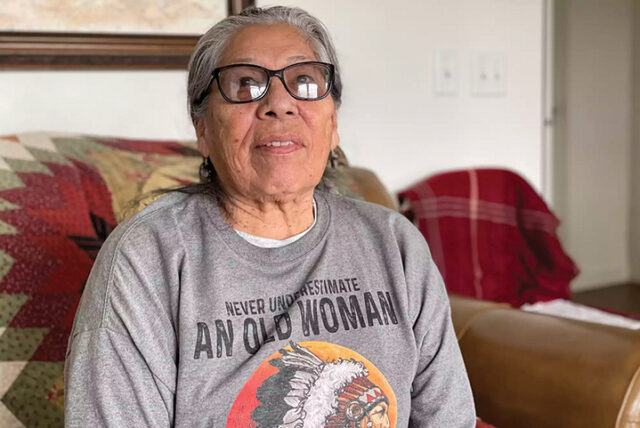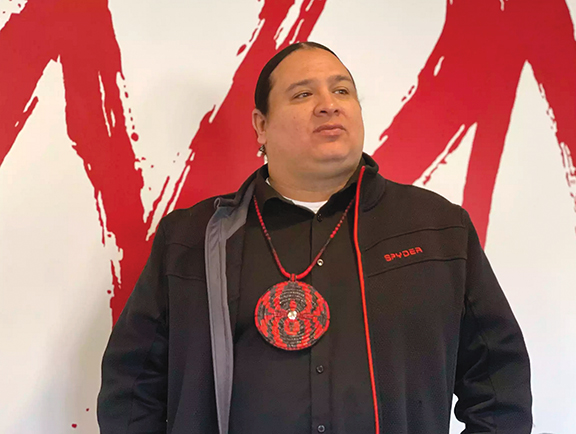
By Associated Press
Madonna Thunder Hawk remembers the firefights. As a medic during the occupation of Wounded Knee in early 1973, Thunder Hawk was stationed nightly in a frontline bunker in the combat zone between Native American activists and U.S. government agents in South Dakota.
“I would crawl out there every night, and we’d just be out there in case anybody got hit,” said Thunder Hawk, of the Oohenumpa band of the Cheyenne River Sioux Tribe, one of four women assigned to the bunkers.
Memories of the Wounded Knee occupation – one in a string of protests from 1969 to 1973 that pushed the American Indian Movement to the forefront of Native activism – still run deep within people like Thunder Hawk who were there.
Thunder Hawk, now 83, is careful about what she says today about AIM and the occupation, but she can’t forget that tribal elders in 1973 had been raised by grandparents who still remembered the 1890 slaughter of hundreds of Lakota people at Wounded Knee by U.S. soldiers.
“That’s how close we are to our history,” she told Indian Country Today (ICT) recently. “So anything that goes on, anything we do, even today with the land-back issue, all of that is just a continuation. It’s nothing new.”

(Photo by Kalle Benallie/Indian Country Today via AP.)
Other feelings linger, too, over the tensions that emerged in Lakota communities after Wounded Knee and the virtual destruction of the small community. Many still don’t want to talk about it.
But the legacy of activism lives on among those who have followed in their footsteps, including the new generations of Native people who turned out at Standing Rock beginning in 2016 for the pipeline protests.
“For me, it’s important to acknowledge the generation before us — to acknowledge their risk,” said Nick Tilsen, founder of NDN Collective and a leader in the Standing Rock protests, whose parents were AIM activists. “It’s important for us to honor them. It’s important for us to thank them.”
Akim D. Reinhardt, who wrote the book, “Ruling Pine Ridge: Oglala Lakota Politics from the IRA to Wounded Knee,” said the AIM protests had powerful social and cultural impacts.
“Collectively, they helped establish a sense of the permanence of Red Power in much the way that Black Power had for African Americans, a permanent legacy,” said Reinhardt, a history professor at Towson University in Towson, Maryland.
“It was the cultural legacy that racism isn’t OK and people don’t need to be quiet and accept it anymore,” he said. “That it’s OK to be proud of who you are.”
A series of events in South Dakota in recent days recognized the 50th anniversary of the occupation, including powwows, a documentary film showing and a special honor for the women of Wounded Knee.
‘Thunderbolt’ of protest
The occupation began on the night of Feb. 27, 1973, when a group of warriors led by Oklahoma AIM leader Carter Camp, who was Ponca, moved into the small town of Wounded Knee. The group took over the trading post and established a base of operations along with AIM leaders Russell Means, of the Oglala Sioux Tribe; Dennis Banks, who was Ojibwe; and Clyde Bellecourt, of the White Earth Nation.
Within days, hundreds of activists had joined them for what became a 71-day standoff with the U.S. government and other law enforcement.
It was the fourth protest in as many years for AIM. The organization formed in the late 1960s and drew international attention with the occupation of Alcatraz in the San Francisco Bay from 1969-1971. In 1972, the Trail of Broken Treaties brought a cross-country caravan of hundreds of Indigenous activists to Washington, D.C., where they occupied the U.S. Bureau of Indian Affairs headquarters for six days.
Then, on Feb. 6, 1973, AIM members and others gathered at the courthouse in Custer County, South Dakota, to protest the killing of Wesley Bad Heart Bull, who was Oglala Lakota, and the lenient sentences given to some perpetrators of violence against Native Americans. When they were denied access into the courthouse, the protest turned violent, with the burning of the local chamber of commerce and other buildings.
Three weeks later, AIM leaders took over Wounded Knee.
“It had been waiting to happen for generations,” said Kevin McKiernan, who covered the Wounded Knee occupation as a journalist in his late 20s and who later directed the 2019 documentary film, “From Wounded Knee to Standing Rock.”
“If you look at it as a storm, the storm had been building through abuse, land theft, genocide, religious intoleration, for generations and generations,” he said. “The storm built up, and built up and built up. The American Indian Movement was simply the thunderbolt.”
The takeover at Wounded Knee grew out of a dispute with Oglala Sioux tribal leader Richard Wilson but also put a spotlight on demands that the U.S. government uphold its treaty obligations to the Lakota people.
By March 8, the occupation leaders had declared the Wounded Knee territory to be the Independent Oglala Nation, granting citizenship papers to those who wanted them and demanding recognition as a sovereign nation.
The standoff was often violent, and supplies became scarce within the occupied territory as the U.S. government worked to cut off support for those behind the lines. Discussions were ongoing throughout much of the occupation, with several government officials working with AIM leaders to try and resolve the issues.
The siege finally ended on May 8 with an agreement to disarm and to further discuss the treaty obligations. By then, at least three people had been killed and more than a dozen wounded, according to reports.
Two Native men died. Frank Clearwater, identified as Cherokee and Apache, was shot on April 17, 1973, and died eight days later. Lawrence “Buddy” Lamont, who was Oglala Lakota, was shot and killed on April 26, 1973.
Another man, Black activist Ray Robinson, who had been working with the Oglala Sioux Civil Rights Organization, went missing during the siege. The FBI confirmed in 2014 that he had died at Wounded Knee, but his body was never recovered. A U.S. marshal who was shot and paralyzed died many years later.
Camp was later convicted of abducting and beating four postal inspectors during the occupation and served three years in federal prison. Banks and Means were indicted on charges related to the events, but their cases were dismissed by a federal court for prosecutorial misconduct.
Today, the Wounded Knee National Historic Landmark identifies the site of the 1890 massacre, most of which is now under joint ownership of the Oglala Sioux and Cheyenne River Sioux tribes.
The tribes agreed in 2022 to purchase 40 acres that included the area where most of the carnage took place in 1890, the ravine where victims fled and the area where the trading post was located.
The purchase, from a descendant of the original owners of the trading post, included a covenant requiring the land to be preserved as a sacred site and memorial without commercial development.
And though internal tensions emerged in the AIM organization in the years after the Wounded Knee occupation, AIM continues to operate throughout the U.S. in tribal communities and urban areas.
In recent years, members participated in the Standing Rock protests and have persisted in pushing for the release from prison of former AIM leader Leonard Peltier, who was convicted of two counts of first-degree murder despite inconsistencies in the evidence in the deaths of two FBI agents during a shootout in 1975 on the Pine Ridge Indian Reservation.
A new generation
Tilsen, now president and chief executive of NDN Collective, an Indigenous-led organization centered around building Indigenous power, traces the roots of his activism to Wounded Knee.
His parents, JoAnn Tall and Mark Tilsen, met at Wounded Knee, and he praises the women of the movement who sustained the traditional matriarchal system during the occupation.
“I grew up in the American Indian Movement,” said Tilsen, a citizen of the Oglala Lakota Nation. “It wasn’t a question about what you were fighting for. You were raised up in it. In fact, if you didn’t fight, you weren’t going to live.”
Tilsen credits AIM and others for most of the rights Native Americans have today, including the ability to operate casinos and tribal colleges, enter into contracts with the federal government to oversee schools and other services, and religious freedom.
He said the movement showed the world that tribes were sovereign nations and their treaties were being violated. And when AIM and spiritual leaders such as Henry Crow Dog, Leonard Crow Dog and Matthew King joined the fight, it became intergenerational.
“It became a spiritual revolution,” he said. “It also became a fight that was about human rights. It became a fight that was about where Indigenous people aren’t just within the political system of America, but within the broader context of the system; of the world.”
Tilsen appreciates that his parents were willing to participate in an armed revolution to achieve one of their dreams of establishing KILI radio station, known as the “Voice of the Lakota Nation,” which began operating in 1983 as the first Indigenous-owned radio station in the United States.
The Dakota Access Pipeline protest in 2016 became a defining moment for him and his brother. They had wondered, he said, what would be their Wounded Knee?
“What made it so powerful and what made it different was that you actually had grassroots organizers and revolutionaries and official tribal governments coming together, too,” Tilsen said. “I think that Standing Rock in particular actually reached way further than Wounded Knee because of how the issue was framed around ‘water is life.’”
Alex Fire Thunder, deputy director of the Lakota Language Consortium, said the occupation of Wounded Knee and other activism helped revitalize Indigenous languages and cultures. His mother was too young to have participated in the occupation but he said she remembered visits from AIM members in the community.
“The whole point of AIM, the American Indian Movement, was to bring back a sense of pride in our culture,” Fire Thunder, Oglala Lakota, told ICT.
Future generations
For Thunder Hawk, the issues became her lifelong work rather than momentary activism.
She joined AIM in 1968 and participated in the occupation at Alcatraz, the BIA headquarters, the Custer County Courthouse and Wounded Knee, as well as the Standing Rock pipeline protest in 2016.
She said work being done today by a new generation is a continuation of the work her ancestors did.
“That’s why we were successful in Indian Country, because we were a movement of families,” she said. “It wasn’t just an age group, a bunch of young people carrying on.”
She hopes her legacy will live on, that her great-great-grandchildren will see not just a photo of her but know what she sounded like and the person she seemed to be.
It’s something that she can’t have when she looks at a photo of her paternal great-grandparents.
“Hopefully that’s what my descendants will see, you know?” she said. “And with the technology nowadays, they can press a button, maybe, and it’ll come up.”






